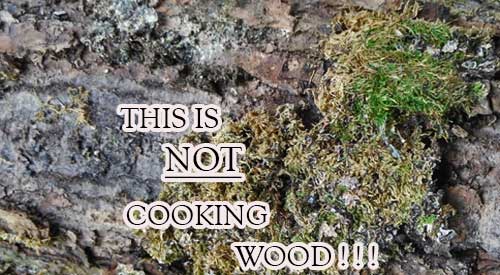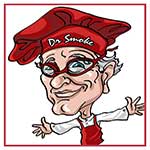Thu 7 May 2020
GRILL WITH MOLDY WOOD? PLEASE DON’T
Posted by DrSmokeRead other related stories: Cooking , General Smoking Information , Smoking Tips
[12] Comments

Learn why moldy hardwood is unfit for cooking and smoking food. Do not GRILL WITH MOLDY WOOD!
SHOULD YOU GRILL WITH MOLDY WOOD? Click To Tweet

listen to Grill with Moldy Woods
There are many opinions out there in the BBQ world when it comes to the wood used for smoking and grilling. Some people preach it doesn’t matter where the wood comes from as long as it isn’t a treated lumber. Comments include, “don’t worry if there are bugs or bug holes – if they’re in there, they’ll just burn up”, or “fires are hot so anything on the wood just burns so you can grill with moldy wood”.
But you should worry. Here’s why not to grill with moldy wood.
In the USA, we try hard to re-purpose items so our landfills aren’t overflowing. What we fail to do, however, is ponder the history of that re-purposed item. Let’s take the common wooden pallet for example.
Wooden pallets have enjoyed a rebirth with the DIY generation. Everything from headboards and wine racks, to dining tables and wedding guest books, have been constructed from the used wooden pallet. What should be widely discussed, is the potential for toxic exposure to this wood item. Wood pallets, just like scrap woods, can harbor mold spores as well as chemical residue if they were used to transport items containing or exposed to chemical toxins. Use these discarded items for cooking wood and you introduce a whole host of new risks.
A Primer on Mold
Mold growth is stimulated by three specific needs:
#1 Moisture: Mold spores need moist or damp locations to grow
#2 Food Source: Mold spores need food to survive and they love porous materials
#3 Optimal Temperature: Mold spores can thrive in temperatures from 32° to 120°F and have the highest stimulation rate in temperatures of 70-90°F. Yes, even at the freezing mark, mold spores don’t die, they simply go dormant.
The Look of Mold
Mold has a range of appearances but on wood is mostly reveals itself as a fuzzy or discolored layer on the surface of the wood. Molds are a type of fungus and they grow on wood when the three conditions mentioned above combine. Molds feed on the wood nutrients (cellulose, hemicellulose, and lignin compounds) without weakening the wood itself.
Why is Mold a Risk
Molds produce millions of microscopic spores that can be carried in the air. Mold spores are around us everywhere. They search for the ideal surfaces to land on and grow. When they increase in concentration, allergic reactions are triggered in sensitive individuals. Expand this concentration to multiple locations and you can become highly sick.
Grill with Moldy Wood?
You now know the 3 parameters needed for mold spores to concentrate and thrive. Why would cooking with moldy wood be of concern if you’re simply throwing them into hot coals or exposing them to gas-fueled heating elements?
Because mold spores can survive combustion!
Molds can produce mycotoxins, toxic chemicals that are present on spores and small fragments of mold and fungus that are released into the air. When moldy wood is introduced to fire, these toxins are released into the air and can cause anyone around the equipment to experience coughing, sneezing, eye and throat irritation. If a preexisting condition like asthma is present, symptoms will be worse. This can lead to a compromised lung health and disease.
Remember, mold looks for moisture environments so if you grill with moldy wood, you take the risk of the airborne spores taking harbor on the food being cooked over that wood. The moist surface of the food is a perfect visiting ground.
Appearances Can Be Deceiving
The biggest challenge is it is almost impossible to distinguish toxic molds from non-toxic which is why I recommend that you never use moldy woods for cooking. Some types of molds won’t reveal themselves on the outside of the wood but will be present within the interior wood cells. It is always best to err on the side of caution and dispose of moldy wood or burn it in an outdoor setting not being used for cooking.
Get Rid of Ash
I highly recommend that you safely dispose of all ash from previous wood-fired cooking to decrease the risk of mold spores and fragments. As mentioned above, mold spores can survive combustion and so they can remain active in ashes. Don’t leave old ash laying around and certainly not within the equipment.
Finding hardwoods at the ideal moisture level, storing the woods in a well-ventilated area, and rotting wood to circulate air exchange are good practices to help you stay safe during the outdoor cooking season and maintain healthy lung function for life.
Other related reading:
10 THINGS TO CONSIDER BEFORE PURCHASING WOOD FOR COOKING, GRILLING & SMOKING
BOOST UP THE FLAVOR OF YOUR SMOKER BOX!
BEYOND PRICING: THE TOP THINGS TO CONSIDER WHEN PURCHASING COOKING WOOD
Products discussed in this blog:
Wood Chunks- Double & Single Filet

Dr. Smoke- The inclusion of bark in a smoker adds impurities. Mold on bark or wood can transfer impurities to your food. We are a NO bark advocate and recommend to not grill with moldy wood.
May 15th, 2018 at 9:52 am
[…] SHOULD YOU GRILL WITH MOLDY WOODS? […]
June 12th, 2018 at 11:30 am
I have peeled about half a cord of alder wood, getting rid of ALL bark residue. However, when I stored these sticks in my shed the pieces at the bottom of the pile developed a bit of blue mold. Right now I am brushing off the mold with a wire brush. My question is…is this sufficient to make it safe enough to use in my smokehouse?
June 13th, 2018 at 10:39 am
If the mold you are describing is a blue-green hue, that is an algae. Using a wire brush is a great start but you should also spray the wood with a mixture of white vinegar to water (1:3 works well). Keep in mind, there could be a combination of mold spores present so it is always best to wear a mask when brushing as you will release those spores into the air. After the vinegar wash, air dry and you should be good to go. If you have a large amount of wood stored, you may want to spray the remaining pieces with the vinegar mixture every couple of weeks.
December 2nd, 2018 at 12:44 pm
I bought a package of Wood chips for smoking/barbecuing but I recently noticed there is a hole in it and they seem to be molding a bit. I am wondering if they would still be safe to use?
December 5th, 2018 at 7:24 pm
Excellent question! Unfortunately, that is the risk with wood product that is packaged in bags. They can tear either in transit or when unloaded. The biggest concern is contamination from something else. Although you may see mold, often this could be another bacterium. If you really want to use the wood, then consider cleansing it in a 1:3 part mixture of white vinegar to water. Be sure the chips are allowed to drip dry following the soaking and store in a container that allows for good air circulation
May 15th, 2019 at 4:06 am
Hello Dr Smoke
Hope you don’t mind me resurrecting a question raised with you back in June 2018.
How long does the 1:3 vinegar/water mixture take to kill off the mold and/or algae?
Should the whole piece of wood be sprayed or just the infected bits?
Does the vinegar leave its own taint on the wood?
Does a stronger vinegar/water mixture work quicker?
Do appreciate your making this site available
thanks in advance
May 15th, 2019 at 4:24 pm
Thanks for the question and we love when our followers revisit previous postings with additional questions.
The vinegar and water mixture can activate immediately but only if the ratio is ideal for the type and quantity of mold. You should spray the entire piece of wood and not just what you see as spores can be developing elsewhere but not revealed full molecular structure. There is a subtle influence from the white vinegar on the wood but this is not notable when the wood is exposed to heat and begins combustion.
Regarding your question of a “stronger mix of vinegar and water,” here’s some additional science:
When an acid like vinegar is diluted with water, the concentration of free-floating hydrogen ions decreases. This results in a higher pH value. On the pH scale, which runs from 0 to 14, the pH level of vinegar is between 2 and 3. Water has a pH level of 7, which means it is neutral. A substance with a pH level below 7 is acidic, and a substance with a pH level above 7 is alkaline. Diluting vinegar with water increases its pH value, because vinegar is an acid and water has a higher pH level. However, adding water to vinegar can never turn vinegar into an alkaline, because water has a neutral pH. Vinegar is a diluted form of acetic acid, with acetic acid making up 4 percent to 6 percent of the vinegar’s content, depending on the brand and type of vinegar. When water is added to vinegar, the vinegar’s acidity decreases, which results in a higher number on the pH scale. The more water added, the more the pH level will increase. However, diluting vinegar with water can never make it alkaline, because water itself is not alkaline; the pH of the mixture can’t be higher than the higher pH value of the two components. A stubborn mold and mildew may require more vinegar which I recommend should be at least 5 percent acidity (as in distilled white vinegar) and the vinegar/water mixture should be at least 50 percent vinegar. So, the answer isn’t that a stronger acidic level works quicker, it’s that it will work period on a stubborn mold.
May 17th, 2019 at 11:21 pm
Thanks for taking the time to respond!
Much appreciated!
June 13th, 2019 at 10:41 am
[…] be overpowering to those who aren’t used to smoked foods. It also is a hardwood that can mold easily especially when exposed to significant variations in temperature and humidity. Additionally, it […]
November 17th, 2021 at 8:54 pm
I like your wood tips. I need to get a contractor. My walls needs some replacing.
September 16th, 2023 at 6:20 pm
Split several pecan limbs last week. Then, it rained after I stacked them (uncovered unfortunately).
Many have spots, patches of mold. Currently, I have them lined up in the sun for a few days to dry out more.
Assuming I spray them with the vinegar solution suggested above, after wire brushing them, should we be good to go after they dry?
It seems unlikely that any wood stored outside would be completely free from mold.
September 17th, 2023 at 2:05 pm
You are correct! Wood will always be susceptible to mold spores and fungus dependent on climate conditions (temperature, humidity level, sunlight, etc.). You are handling this situation correctly: air dry in the sun, then spray with a vinegar/water solution and brush any residual spores. You will take care of any risk factor with these steps. Enjoy the great flavor of pecan!